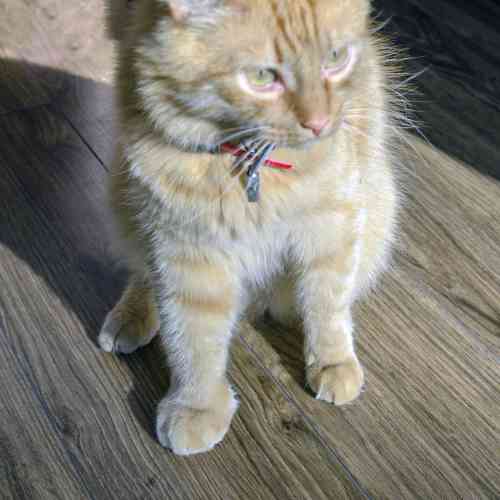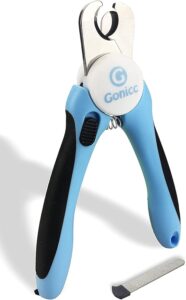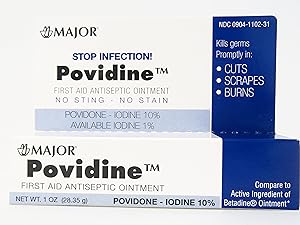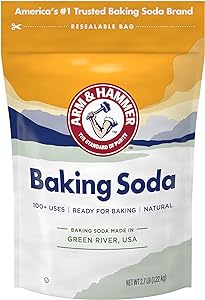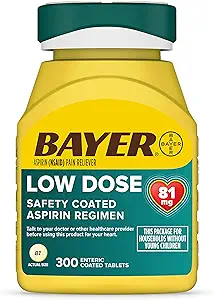Your cat has a swollen paw
Possible causes and DIY treatments
In this article, we discuss the symptoms you might see if your cat has a swollen paw. We’ll tell you about the possible causes of a swollen paw in your cat and how you can try to diagnose it yourself. We also give advice on how you can treat your cat’s problem yourself. We hope to help you in treating your cat’s swollen paw. With your good care, he should recover quickly.
Symptoms of a swollen paw in your cat
In addition to your cat having a very swollen paw or foot, there are other symptoms you might notice in the case of a swollen paw in your cat. For example:
- a painful paw when touched
- limping
- red skin on your cat’s swollen paw
- your cat licks a lot at its swollen paw
- the paw feels warmer than its healthy paw
- your cat has a fever
- your cat eats less
- your cat is less active
Causes of a swollen paw in your cat
Abscess most common cause of a swollen paw in cats
In many cases, the cause of a swollen paw in your cat is an abscess. An abscess occurs when your cat gets a small wound in its skin where deep in the wound, under the skin, a bacterium has entered. This can happen, for example, as a result of a fight with another cat. The nail or tooth of the other cat pierced your cat’s skin and left a bacterium deep in the wound. Your cat’s body sends pus-cells to the bacterium, but cannot control it quickly enough. So more and more pus-cells are sent. This accumulates under the skin in a cavity, along with the formed bacteria.
An abscess is essentially an under-skin infection and causes an inflammatory reaction. This is very painful for your cat. In most cases, your cat will also eat less, limp, and get a fever. After 2-3 days, the abscess bursts open, and a lot of extremely smelly and bloody pus pours out of your cat’s paw. It looks extremely dramatic to the owner at that point, but for your cat, the pressure of the abscess is off, and it has much less pain.
Bruised paw
When your cat has had an accident, it may happen that its muscles, tendons, or joints are damaged. Since there is damaged tissue in your cat’s paw, its body tries to clean that up. It does this by sending a lot of fluid there. This contains healing substances and ensures that your cat will use its paw less. The downside of this amount of fluid is only that your cat’s paw becomes quite swollen and painful. Your cat will limp, but in most cases, it will still put some weight on its paw.
Insect sting in the summer common cause of a swollen paw in a cat
In the warm summer months, cats also sometimes tend to “play” with wasps or bees. Or other stinging insects. As a result, such an insect can sting your cat. The result is that your cat’s paw can swell considerably. Usually, you then see a very small puncture hole in the center of that swelling. But such a hole is also sometimes seen with an abscess. In most cases, this swelling based on an insect sting resolves itself within 3-4 days.
Fracture
If your cat has had a serious accident, it is possible that there is a fracture in one or more bones of its paw. In that case, its paw is extremely painful and often dangles in an unnatural position on your cat. Your cat almost always walks on 3 legs if its paw is broken, and if you get the chance to examine its paw, you often feel something “crackly/crispy” at the level of the fracture. Do you think the swollen paw in your cat may be caused by a fracture? Then it is of course best to have an X-ray taken at your veterinarian to know for sure. The treatment then depends on the type of fracture. Your vet will tell you more about this. In most cases, surgery or a cast is needed.
Ingrown nails common cause of a swollen paw in an old cat
We especially see ingrown nails in older cats. Due to their old age and perhaps due to arthritis in their joints, they have moved less and therefore have not kept their nails short. Eventually, they grow in a circle and prick the sole cushions of that nail. If it is not resolved then, they also start to cause wounds in the sole cushions, and these in turn become infected, causing them to swell and thus cause a thick foot in your cat. It can be about 1 nail, but also about several. So take a good look at your cat’s nails if your cat’s foot has become thick.
Inflamed footpads
Elastic band around paw common cause of a swollen paw in a young cat
Fortunately, it does not happen very often, but cats also sometimes play with elastic bands. In some cases, such an elastic band, can get stuck around its paw. This impedes the blood circulation of your cat’s paw. The blood can still be pumped into the paw, but getting out is much more difficult. And lymph fluid can also still get in, but getting out is almost impossible. The result is that the part of the paw under the elastic band becomes completely swollen and painful. Does your cat have a swollen paw? Then check well if there is no elastic band or other string just above the swelling.
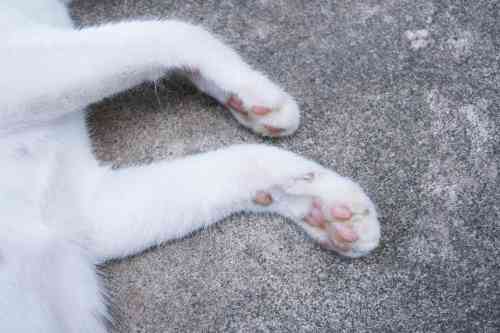
How do you examine a swollen paw in your cat?
Take its temperature
The treatment of a swollen paw in your cat depends of course on what the cause is. So you will first have to examine your cat’s paw well yourself. Start by taking its temperature by inserting a rectal thermometer into its anus. Normal body temperature for a cat ranges between 100.5 to 102.5 degrees Fahrenheit (38.1 to 39.2 degrees Celsius). If its temperature is higher, your cat probably has a fever due to an abscess as the cause of its swollen paw. The reason you should first take your cat’s temperature is that your cat will no longer cooperate with taking its temperature if you have first hurt it with the examination of its paw.
Check the nails and constricting objects like elastic bands
After taking your cat’s temperature, you examine its paw. First, check if there is no elastic band or string around its paw. And if the swelling is mainly on its foot, then you check the length of its nails. Also, check if you see wounds in its footpads.
Bend and stretch joints of a swollen paw in your cat
Then try if you may and can bend and stretch each joint of the paw in a normal way. This often already gives you a better picture of which part of the paw the problem is. If the swelling is very local, you can gently palpate that part and feel if there is perhaps mobility in the bones that should not be there. In that case, there is a fracture.
Abscess as the cause of a swollen paw in your cat
In the case of an abscess, the paw at the level of the swelling is very painful. Your cat will probably get quite pissed off if you push on it. Cats with a feisty character can even bite at that moment. So be warned. It is often safer if one person holds your cat by the scruff of the neck while you examine its paw as far away from its mouth as possible.
Is it very painful? Then look at the center of the swelling. With an abscess, you often see a piece of skin in the form of a small circle a few millimeters big with a different sheen/appearance. If you see that between its hairs, you can try to scratch or squeeze that part open. Don’t be shocked if a lot of purulent mess comes out. Although it is really nasty, it does cause a lot less pain for your cat afterwards. It’s better for the pus to be out than to stay in. The best thing is if your cat gets an antibiotic course at your vet, but in most cases, it also resolves itself once the abscess has bursted open.
Wait and see what happens with that swollen paw in your cat
If there is a swelling that is not extremely painful for your cat and it is the summer period, you can also look in the middle of the swelling to see if you see a puncture hole from an insect. Is this the case and does your cat not have a fever? Then you can wait and see for about 3 days. The swelling is probably almost gone by then.
Do you think there is no fracture or abscess? And is there no elastic band or ingrown nails? Then the swollen paw of your cat is probably the result of a bruise. This also resolves itself and should be almost over after a week.
If the swelling still gets bigger or you have doubts, then you better go to your own vet.
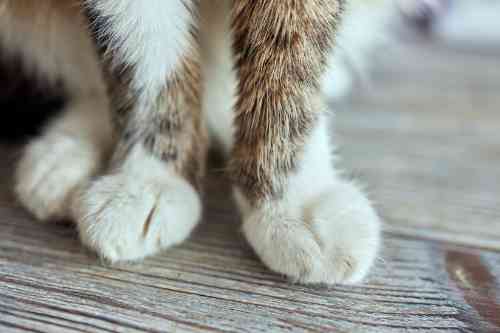
what should you do if your cat has a swollen paw?
Elastic band or other constricting object
If there is something around your cat’s paw, it is enough to remove it with scissors. The swelling should decrease a lot each day. Usually, it is gone after about 3 days. An exception is if you see that the skin of its paw is black or dark purple. In that case, the skin is already dead. In that case, a vet is needed to determine what the best treatment for your cat is now.
Ingrown nails
If your cat has one or more ingrown nails, then you must of course clip its nails. This can sometimes be quite painful if they are ingrown. Yet a veterinarian does not do it differently. Clip the nails off to 1 to 2 millimeters after the quick. Or, if you can’t see it sitting, you clip the nail halfway so that they no longer prick into its paw.
Let your cat rest for a while if it hurt him a lot. Once he has calmed down a bit, apply betadine ointment in a thin layer to the wounds of its footpads. You can optionally continue to do this twice a day for about 5 days. Usually, you see your cat getting a little better every day and the swelling of its paw decreasing significantly.
Inflamed footpads
If your cat has inflamed and swollen footpads, then you should best soak its feet twice a day for a few minutes in a bath with baking soda. Since this is a watery solution, it penetrates well into the depths of the wounds and has an anti-bacterial treatment.
Not all cats appreciate a foot bath. In that case, you can apply honey ointment to the wounds 3 times a day. This also works as an antibacterial and reduces inflammation. Additionally, it is wound-healing, which is naturally very handy if your cat has wounds on its paw pads. However, it doesn’t penetrate as deeply into the wounds.
Abscess
If there is a fever and thus likely an abscess, the abscess should be opened as soon as possible. If you’re having trouble doing it yourself, it’s better to go to your veterinarian. They will prescribe an antibiotic course for your cat and, if possible, open the abscess. If the abscess has already opened naturally, you can also wait and see for about 3 days. Your cat will probably get the abscess under control and resolve it on its own. This process will, of course, be faster if your cat gets an antibiotic course.
A bruise or insect sting
Both of these causes of a swollen paw in your cat typically resolve on their own. An insect sting usually heals within 2-3 days, and a bruise should show significant improvement within a week.
Giving your cat a pain reliever for a swollen paw
A swollen paw is usually somewhat painful for your cat. The best option is to get a pain reliever from your veterinarian that is suitable for your cat. However, almost always, a consultation with your veterinarian is legally required for this.
If you still want to give your cat something for the pain, you can give a half of a 81mg aspirin tablet once every two days (not twice a day!). BEWARE! ONLY ASPIRIN IS SUITABLE. PARACETAMOL, IBUPROFEN, OR OTHER HUMAN PAINKILLERS ARE DEADLY FOR CATS! The aspirin provides pain relief and reduces inflammation in your cat. However, painkillers from your veterinarian that are specially made for your cat work better. Therefore, it is preferable to give those to your cat.
Frequently asked questions about a swollen paw in a cat (FAQ)
Can my cat go outside with its swollen paw?
It can, but it’s better to keep your cat inside. This way, its paw gets more rest and thus a chance to heal. A cat with an abscess might also hide under a bush, causing you to worry for several days.
Can I just play with my cat if it has a swollen paw?
In this case, too, it’s better for your cat to stay calm. This way, its body has more chance to heal the problem.
Can I prevent a swollen paw in my cat?
You can keep checking your cat’s nails to ensure they don’t get too long. But all other causes of a swollen paw in your cat are hard to prevent if your cat goes outside. Therefore, keeping your cat indoors as much as possible could be an option. However, not every cat will be happy with this decision.

